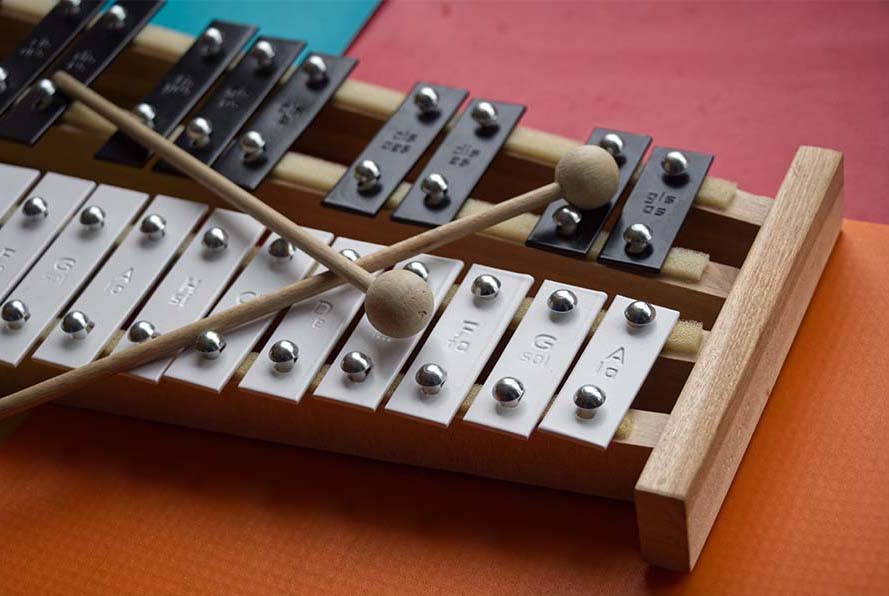Y2. Lesson 17. Major pentatonic scale
Prior learning: Trichord mi-re-do
Duration: 30 minutes
Materials:
Keywords: Beat, rhythm, singing, chanting, partners, rhymes, circle games.
Difficulty: ![]()
Prepare
Present
Major pentatonic scale
Practise
Marching and skipping
 Melodic development
Melodic development
![]() Students discover the five-note major pentatonic scale in a known song.
Students discover the five-note major pentatonic scale in a known song.
- Project the simple score of Bluebells on the board, which shows the solfa instead of lyrics for ease of use.
- Lead the class in singing the song, initially using the lyrics.
- Next, repeat using solfa and hand signs. Pointing to the solfa on the board as you sing may be helpful.
- Ask which is the lowest note [do] and sing it.
- Ask which is the highest note [la] and sing it.
- Ask how many different notes in total [5].
- Ask the class to follow you, singing the five notes [do, re, mi so, la].
- Ask students to identify whether the intervals between the notes are skips or steps.
- Teach that these five notes are called the pentatonic scale.
 Rhythmic development
Rhythmic development
![]() Students read rhythms on the board and find the song.
Students read rhythms on the board and find the song.
- Project the graphic on the board.
- Ask students to clap the first line and tell you the song's name. There are some obvious hints to help.
- Ask students to clap and say the time names.
- When a correct answer is received, move to the second line and repeat the process.
- Continue until all songs are named.

 Creative movement
Creative movement
![]() Students unconsciously move to 6/8 time in this classic game.
Students unconsciously move to 6/8 time in this classic game.
- Students form a large circle and hold hands.
- One student is chosen to patrol the inside of the circle, moving in the opposite direction of the students in the circle.
- Lead the class in singing the first verse.
- Students in the circle will move clockwise to the beat as the chosen student moves anticlockwise.
- At the end of the verse, the chosen student picks another student to join them in the circle.
- The game recommenced as before, but with both students moving in the opposite direction to the main circle.
- At the end of the verse, a third student is chosen, and the game continues, with extra students being added to every verse.
 Listening
Listening
![]() Students echo sing intervals to discover whether they are in skips or steps.
Students echo sing intervals to discover whether they are in skips or steps.
- Students are seated and attentive.
- Explain that you will sing an interval, and students, as musical detectives, will respond by stating step or skip.
- Sing the interval, and students should echo back.
- Sing do-re [step]
- Sing re-mi [step]
- Sing mi-so [skip]
- Sing so-la [step]
- Continue in reverse order.
- Extension: Repeat the process using hand signs.
 Visual learning
Visual learning
![]() Students deepen their knowledge of the tone ladder for the major pentatonic scale.
Students deepen their knowledge of the tone ladder for the major pentatonic scale.
- Students are seated and attentive.
- Project the tone ladder on the board.
- Sing the pentatonic scale as you point to each note in turn.
- Ask students to copy you.
- Choose a student to come forward and point as the class sings again.
- Teach the name of the scale [pentatonic].
- Ask students the interval between the notes- whether a step or a skip apart.
 Instruments
Instruments
![]() Students discover the notes of the major pentatonic scale on tuned percussion.
Students discover the notes of the major pentatonic scale on tuned percussion.

- Distribute tuned percussion instruments so there is one instrument per two students.
- If possible remove the unwanted bars, leaving F, G, A, C, D [in the key of F] or C, D, E, G, A [in the key of C].
- Students form pairs. One student from each pair will follow you playing a major pentatonic scale.
- When secure, students swap and the process repeats.
- Ask the class what scale were they playing.
 Part work
Part work
![]() Students practise a pentatonic song with a bordun [drone] on tuned percussion.
Students practise a pentatonic song with a bordun [drone] on tuned percussion.
- Have xylophones or glockenspiels available and distributed for up to half the class.
- Divide the class into players and singers.
- Players will play a steady do or do-so accompaniment. on their instruments as the singers sing Buttercup.
- When the class is ready, conduct students in singing and playing.
- The song is based on the major pentatonic and is perfect for a drone-type accompaniment.

Students section

Try these quick questions!
 Assess
Assess
Suggested lessons
Y1. Beat II

Y1. Beat III

Y1. Beat IV

